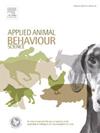Behavioral responses during and after a postpartum human-animal interaction in rangeland breeding ewes
IF 2
2区 农林科学
Q1 AGRICULTURE, DAIRY & ANIMAL SCIENCE
引用次数: 0
Abstract
Lamb welfare, performance and survival on rangeland is partially determined by the quality of maternal care received (i.e., high durations of sniffing/grooming, allowing udder access, and staying close to the lamb). Previous studies have explored maternal behavior scores (MBSs), as a tool to select ewes based on their proximity to the lamb and the shepherd, finding variable evidence towards sensitivity and robustness in scores in ability to gauge lamb outcome (birth weight and weaning weight), survival, and maternal care throughout the lambing season. Though this scoring system is convenient, there may be another behavioral attribute related to fear of human or relationship to the human handler may be elicited during lamb collection and processing. This longitudinal study investigated the presence of a trait in response to the human handler employing a Lamb Handling (during processing) and a Lamb Tie Down (after processing) test with N= 42 total ewes and n=26 ewes consistently present across both years of the study. The current study also set out to investigate the relationship between proximity to the shepherd and lamb outcome. Attempts to perform principal component analysis revealed that variables from the Lamb Handling and Lamb Tie down test were not suitable for factor analysis. In the Lamb Handling test, proportion of ‘pacing’ was a nearly significant, negative predictor (P=0.07) term in the binary ‘investigating human’ model, improved model fit and explained more variance compared to the null model [(cumulative weight: 90 vs 10 %); (R2adjusted: 30.8 vs 15.2 %; deviance= 31 vs 18.5 %)]. A random term for individual also improved fit in this model, indicating a potential behavioral trait driven by the ewe related to fear or perception of the human. The occurrence of grazing (0 or 1) was a nearly significant, positive predictor (P=0.06), improved model fit and explained more variance in the ‘investigating human’ model compared to the null model [(cumulative weight: 76 vs 24 %); (R2adjusted: 21 vs 15.2 %; deviance= 26.8 vs 18.5 %)]. Individual did not improve model fit in the relationship between ‘investigation human’ and ‘grazing’. Weaning weights were a nearly significant positive predictor in the model for ‘close proximity’ at lamb collection (P=0.07) and a significant positive predictor for ‘close proximity’ during processing (P<0.001), however, did not improve model fit over the null. Birth weights improved model fit for behaviours including ‘sniffing/grooming’ and ‘pawing’ in the Lamb Tie Down test and these behaviours may have been moderated by maternal investment in heavier lambs. Behavioural responses, expanding beyond proximity measures, can be useful for gauging maternal attachment and investment in the lamb during and after processing. Fear or perception of humans should also be considered as contributors to the response to the shepherd during human-animal interactions in the lambing season.
牧场繁殖母羊产后人兽互动期间和之后的行为反应
羔羊在牧场上的福利、表现和存活率在一定程度上取决于母性照料的质量(即长时间的嗅闻/梳理、允许接触乳房和靠近羔羊)。以往的研究探讨了母性行为评分(MBSs),将其作为根据母羊与羔羊和牧羊人的亲近程度来选择母羊的工具,结果发现,在衡量羔羊结果(出生体重和断奶体重)、存活率以及整个产羔季节的母性照料能力方面,评分的灵敏度和稳健性各不相同。虽然这种评分系统很方便,但在收集和处理羔羊的过程中,可能会激发出另一种与惧怕人类或与人类饲养者关系有关的行为属性。本纵向研究采用羔羊处理(处理过程中)和羔羊捆绑(处理后)测试,调查了母羊对人类处理者的反应特质的存在情况,在研究的两年中,共有 42 只母羊和 26 只母羊持续存在这种特质。本研究还旨在调查与牧羊人的距离与羔羊结果之间的关系。尝试进行主成分分析后发现,羔羊处理和羔羊绑缚测试中的变量不适合进行因子分析。在羔羊处理测试中,"起搏 "比例是二元 "调查人类 "模型中一个几乎显著的负预测项(P=0.07),与空模型相比,它改善了模型的拟合度并解释了更多的方差[(累计重量:90 vs 10 %);(R2调整后:30.8 vs 15.2 %;偏差= 31 vs 18.5 %)]。个体的随机项也提高了该模型的拟合度,表明母羊的潜在行为特征与对人类的恐惧或感知有关。在 "调查人类 "模型中,放牧发生率(0 或 1)是一个近乎显著的正向预测因子(P=0.06),与无效模型相比,它提高了模型的拟合度并解释了更多的变异[(累计重量:76 vs 24 %);(R2 调整后:21 vs 15.2 %;偏差= 26.8 vs 18.5 %)]。个体并没有改善 "人类调查 "与 "放牧 "之间关系的模型拟合。断奶体重在羔羊采集时的 "接近 "模型中是一个近乎显著的正向预测因子(P=0.07),在加工过程中的 "接近 "模型中也是一个显著的正向预测因子(P<0.001),但与空值相比,并未改善模型拟合。出生体重提高了 "拴系羔羊 "试验中 "嗅闻/梳理 "和 "用爪子抓 "等行为的模型拟合度,这些行为可能受到母体对较重羔羊投资的影响。行为反应超出了近距离测量的范围,可用于衡量母性对羔羊的依恋以及在处理过程中和处理后对羔羊的投资。在产羔季节人与动物的互动中,对人类的恐惧或感知也应被视为对牧羊人反应的影响因素。
本文章由计算机程序翻译,如有差异,请以英文原文为准。
求助全文
约1分钟内获得全文
求助全文
来源期刊

Applied Animal Behaviour Science
农林科学-行为科学
CiteScore
4.40
自引率
21.70%
发文量
191
审稿时长
18.1 weeks
期刊介绍:
This journal publishes relevant information on the behaviour of domesticated and utilized animals.
Topics covered include:
-Behaviour of farm, zoo and laboratory animals in relation to animal management and welfare
-Behaviour of companion animals in relation to behavioural problems, for example, in relation to the training of dogs for different purposes, in relation to behavioural problems
-Studies of the behaviour of wild animals when these studies are relevant from an applied perspective, for example in relation to wildlife management, pest management or nature conservation
-Methodological studies within relevant fields
The principal subjects are farm, companion and laboratory animals, including, of course, poultry. The journal also deals with the following animal subjects:
-Those involved in any farming system, e.g. deer, rabbits and fur-bearing animals
-Those in ANY form of confinement, e.g. zoos, safari parks and other forms of display
-Feral animals, and any animal species which impinge on farming operations, e.g. as causes of loss or damage
-Species used for hunting, recreation etc. may also be considered as acceptable subjects in some instances
-Laboratory animals, if the material relates to their behavioural requirements
 求助内容:
求助内容: 应助结果提醒方式:
应助结果提醒方式:


